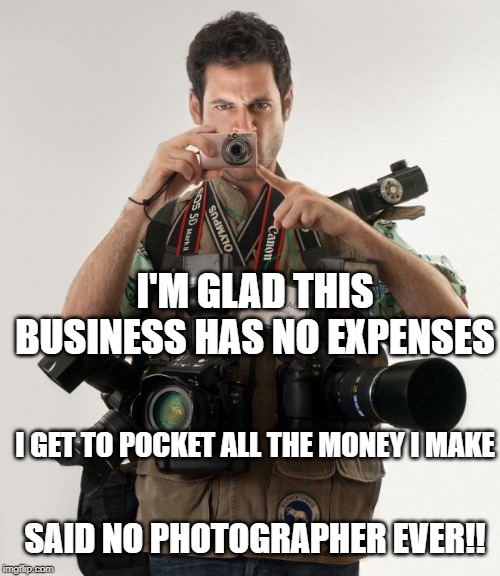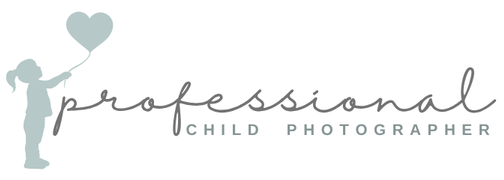The Real Cost of ‘FREE’ Photography – The Real Cost of Cheap
Do any of these requests sound familiar to you?
“Would you donate a session to our school fundraiser?”
“You should do a raffle for a free session!”
“My friend is a photographer and she does free sessions all the time. Why don’t you?”
“Can you offer special sessions for kids with special needs at a reduced rate?”
As a professional photographer, you’ve very likely had one or more of these type of requests. If you’re NOT a photographer, you might be wondering why these seem like reasonable asks. After all: What’s one free session? You’re already there with your camera. How much could it really cost you?
Let’s talk about how “just one free session” isn’t actually free – and why constantly asking photographers to give away their work hurts everyone in the long run.
It’s Not Just Clicking a Camera – Or Owning A Pair of Kitchen Scissors
Here’s where we need to start: photography is so much more than showing up and clicking a button.
Think about the last time you got your hair cut and colored. You went to a skilled professional and didn’t just pay for your stylist to snip with kitchen scissors and apply single toned box hair color for an hour, right? What did you pay for? You paid for his/her time that day + all the years they have trained + their artistic eye + use of their specialized tools and products – wielded by, yet again – their skilled hands. Also the overhead of running their (spot in the) salon plus all their supplies, and finally, yes – the actual time they spent working on your hair.
Photography pretty much works the same way.
Let’s Compare Photography to Other Professions

Imagine walking into your dentist’s office and telling them: “I’d like for you clean my teeth for free! I have a special situation and regular dental prices are just too much, and it won’t take much time and I’m already here.” Or asking your lawyer to donate their time to review your contracts because “it would only take you an hour, and you’re already a lawyer anyway!”
Sounds kind of absurd, right?
Yet photographers hear these requests with great regularity. Why do we suppose that is? There’s a perception that what professional photographers do is “easy” & “fun”! That it requires no time or equipment investment. And because art is typically devalued in our society, somehow photographic creativity and the creation of is less valuable than other professional services. After all, everyone has a camera on their phone now, so “how hard can it be?”
But consider this: everyone has kitchen knives but you still pay a surgeon to cut into you. Everyone has a car and a set of wrenches but you still pay a mechanic. Owning the tools doesn’t make you a professional – years of training, experience, and skill development do.
The Devaluation
Here’s where it gets tricky for the entire photography industry: when photographers are expected to regularly give away sessions, there becomes an expectation that photography has no inherent value – from its’ inception to final product.
When one photographer does free raffles the public may start expecting ALL photographers to do them. When someone offers deeply discounted “special needs sessions” or “military family sessions” or “teacher appreciation sessions,” it trains the market to believe that’s what photography should cost: NOTHING.
Pretty soon, you’ve got photographers spending $300 on props for mini sessions and booking only 2 out of 20 $100 slots because everyone’s competing on who can give away the most for the least amount of money (true story…more on that in an upcoming post!).
This creates a race to the bottom that affects everyone. When photographers can’t earn a living wage, they either quit entirely or they start cutting corners: they may start skipping equipment maintenance, letting their professional organization memberships lapse, avoiding professional development and education, then taking on more sessions and in the process they rush through editing and the client experience suffers. Quality drops across the board. “I don’t know what happened…their work used to be sooooo good!”
It’s like when the only grocery store in your neighborhood can’t stay in business because everyone drives 30 miles for cheaper prices. Sure…you did save a few bucks – but now when you need milk at 8 p.m. for that last minute bring to work treat you need to make for that pot luck or at 4 p.m. you realize you need fresh produce for that salad recipe you planned to make for dinner, you’re simply out of luck. The convenience and quality you took for granted? Gone.
Another way to frame it: childcare. If every daycare in town started charging $50/week because one place offered it “cheap,” pretty soon none of them could afford proper staff ratios, background checks, quality toys, or safe facilities. The cheap option seems great until you realize you’re left with only subpar options for your most precious of life’s gifts: your children.
Devalue photography enough and evenutally the same thing happens – the tried and true professionals leave the field and you’re stuck with whatever is left.
“Oh but it’s just photography…”
…but is it, though?
The Power of Photography: Historical Records
Photography, as an art form, elicits emotions in the viewer quite unlike any other art medium. It is a reflection of life, of relationship, of our loved ones.

Humans have been creating visual records for an estimated 52,000 years. Cave paintings of creatures like bison, art of hands of those that had gathered at the cave site have been historically catalogued.
Then there is the gorgeously well preserved Egyptian tomb art depicting families and daily life. The painted portraits of prominent figures hung on walls of castles and palaces and maybe even of some of our ancestors passed down through generations. Why? Because as visual creatures, we humans need to SEE our history. We need to leave proof that we existed, that our loved ones existed, that our stories, that our lives, mattered.
Photography is simply the modern expression of this ancient human need.
Ask yourself: if your house was on fire and everyone was safely out, what would you grab? Not the TV. Not the expensive jewelry. Not the furniture. You’d grab the photo albums. The framed portraits from your wedding when everybody important gathered in one place and celebrated. You would think about the storage media with some of your digital images. Because these things, they are irreplaceable. Furniture? Clothes? Televisions? Everything else can be replaced with money and time. Those moments? Gone forever if they go up in flames (or have smoke and heat damage).
That family photo where Aunt Suzy is smiling at Thanksgiving? She’s been gone three years and the family hasn’t gathered since! That image is the last record of everyone you love in one place. That photograph of your kids at ages 5 and 3, holding hands in the yard where the hydrangeas used to bloom? They’re 15 and 13 now and can barely stand to be in the same room together. But that photograph proves there was a time when they were inseparable, when they loved each other openly and without question.
These aren’t “just pictures.” They’re historical records. They’re proof. They’re evidence. They’re memory made tangible.
The Power of Photography: Self-Esteem
Yes, we live in a world absolutely saturated with imagery. But here’s what gets lost in all that visual clutter: photography can transform how you see yourself. Photography has been credited totransform the way a child sees themselves and helps boost their self-esteem and sense of belonging (it is well known that displayed photos of a family help boost children’s self of being part of something).

But to acquire those kind of images requires skill and technical mastery. A skilled professional photographer understands the technicalities – how their camera works, how light sculpts a face, which angles flatter different body types. They understand what kinds of clothing photograph well on what body types and how their subject’s comfort level (or lack of it) shows up in every image. They understand the fundamentals of posing bodies of all shapes and sizes, from tall and slender to short and curvy.
From my own experiences: I’ve watched countless awkward young adults receive their senior portraits and completely transform. Something about being truly SEEN by another person – being photographed by someone who views you as beautiful and worthy of attention – shifts how you carry yourself afterward. The confidence is undeniable.
And professional headshots? They’re not just vanity. In the age of LinkedIn and digital job hunting, a good to great headshot can be the difference between getting the interview and being scrolled past. It signals professionalism, confidence, approachability. It tells a potential employer: “I take myself seriously. You should too.”
When you devalue photography, you aren’t just hurting photographers’ bottom lines. You’re devaluing the very tool that helps people see themselves as worthy, confident, and professional.
You’re devaluing one of the most basic of human communication tools.
You’re devaluing the thing that people will risk their lives saving from house fires.
You’re devaluing all the Aunt Suzys of this world that look to keep families tied together.
“But It’s For a Good Cause!”
Look, we get it. Schools need fundraising. Charities need support. Special needs families often face higher expenses. Military families sacrifice tremendously. Teachers are chronically underpaid. Each and every one of these is a true and valid concern. Each of these scenarios deserves attention and support.

But here’s the thing: photographers can’t single-handedly solve these societal problems by giving away their labor.
…you don’t expect a mechanic to fix vehicles for free because teachers need reliable transportation.
…you wouldn’t ask your dentist to provide free dental care because military families have medical expenses.
So why are photographers so frequently asked to donate their work?
The assumption seems to be that because photography is creative and (let’s be honest) enjoyable for many of us, it’s not “real work” that deserves fair compensation. But passion for your work doesn’t pay the mortgage. Last time I checked: loving my work and my clients didn’t pay my property taxes. A passionate feeling for what you do doesn’t replace broken equipment or feed your family.
What Photographers CAN Do (And Often Already Are Doing)
This doesn’t mean photographers can’t or don’t support causes they care about. Many of us do! But here’s what most people don’t realize: many photographers already HAVE charitable giving built into their business model – they’ve just set sustainable limits on it.
For instance, a photographer might:
- Set aside a specific dollar amount or percentage of annual revenue for charitable donations
- Reserve 2-3 pro bono sessions per year for causes they’re personally passionate about (or for causes that their wonderful clients are passionate about)
- Commit to one specific charity or cause annually rather than saying yes to every request
So when you ask a photographer to donate a session to your school fundraiser and they say no, please understand that it’s not because they don’t care about education. It’s because they may have already committed their charitable budget to the children’s hospital, the domestic violence shelter, or the animal rescue they support every year.
The reality: If a photographer said yes to every charity request, auction donation, “special rate” plea, and raffled session that comes their way, they’d be working for free 30-40% of the year. That’s not sustainable – not for them, not for their families, and ultimately not for your community who serves so many. Not for YOU when you need a professional photographer who’s still in business to create beautiful family portraits because grandma is now 90 years old and the last surviving member of her siblings and you know tomorrow may just be the day she is gone.
Sustainable ways many photographers may give back:
- Donating a percentage of annual profits to chosen charities
- Donating PRINTS (not sessions) to auction fundraisers
- Offering those 2-3 reserved pro bono sessions per year for specific causes
- Volunteering time for one-time events (like photographing shelter animals or for school fundraising events)
- Teaching workshops with proceeds going to charity
- Offering existing clients the occasional charitable contribution (to a new client) for charities THEY are passionate about
Notice the key difference? These are planned, limited, and sustainable approaches that don’t devalue the photographer’s work or create market-wide expectations that photography should be free or heavily discounted.
The Bottom Line
When you see a photographer’s prices and think “that seems expensive for just taking some pictures,” keep in mind what you’re actually paying for:

You’re not paying for the click of the shutter of their “nice” camera
-You’re paying for years of experience, thousands of dollars in equipment, hours of post-production work, professional expertise, and all the business costs that go into running a legitimate operation.
You’re not just buying prints for today
You’re investing in historical records your someday grown children and grandchildren will treasure. You’re investing in confidence and professional opportunities. You’re investing in proof that your story – your family’s story – mattered.
When you ask a photographer for a free or heavily discounted session, you’re asking them to absorb up to 22+ hours of labor plus their overhead costs. For many photographers, that’s $500-$2,000 in value they’re being asked to give away.
Could they do it “once”? Sure. But if each and every photographer did it regularly for every request that came their way, no photographer could independently sustain their business. Feed their families. Pay for their children’s travel baseball team that your neighbor runs.
Also then where would you go when you actually need professional photography?
The next time you see beautiful photography at a charity event or fundraiser and think “they should do donation all the time to make it more affordable,” remember: they can not. Not if they want to still be there next year when you need someone to photograph your family, your graduate, your new baby, your head shot for that dream job.
Professional photography when done well by a skilled photographer and when done sustainably – has real and lasting value.
Value like that? It deserves to be respected and protected.

For Families:
Looking for a photographer? Start here:
• Why Supporting Small Business Photography Matters
• Why Choose Custom Photography?
• Questions to Ask Your Photographer [there is a pdf download for you print up at this link]
• Photographer Evaluation Checklist
Did you find this article helpful?
You’re welcome to use any portion of this site on your blog, website, or social media pages!
Please credit any excerpts you use on your site or blog by copying and pasting the following on your site or social media page (with appropriate links enabled):
” This article was written by Marianne Drenthe of Marmalade Photography
www.marmaladephotography.com
and can be found at the Professional Child Photography site at
www.professionalchildphotographer.com ”
